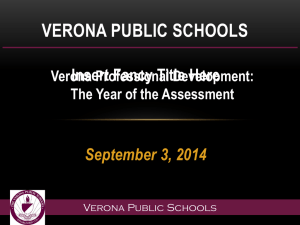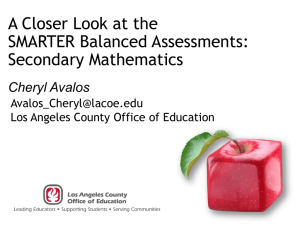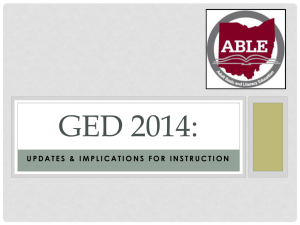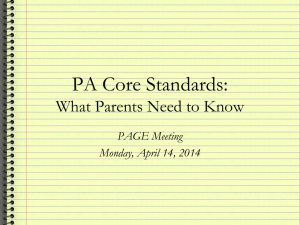Depth of Knowledge
advertisement
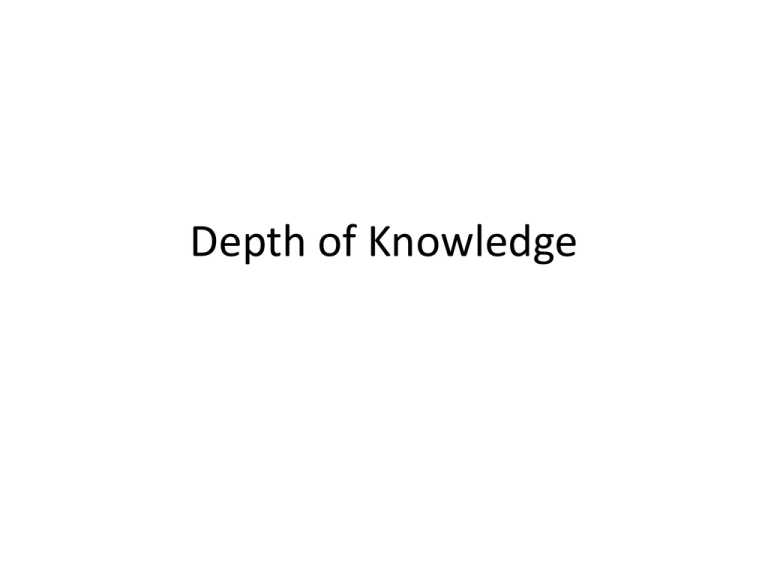
Depth of Knowledge Why Depth of Knowledge? Why Depth of Knowledge? • Mechanism to ensure that the intent of the standard and the level of student demonstration required by that standard matches the assessment items (required under NCLB) • Provides cognitive processing ceiling (highest level students can be assessed) for item development • Designed for use with assessments Copyright ©2010 Commonwealth of Pennsylvania 2 Depth of Knowledge (DOK) Webb’s Depth of Knowledge Recall and Reproduction Level 1 Skills and Concepts Level 2 Strategic Thinking Level 3 Extended Thinking Level 4 Copyright ©2010 Commonwealth of Pennsylvania 3 Depth of Knowledge (DOK) Recall and Reproduction: Level 1 •DOK 1 requires recall of information, such as a fact, definition, term, or performance of a simple process or procedure, as well as performing a simple algorithm or applying a formula. •Answering a Level 1 item can involve following a simple, well-known procedure or formula. Simple skills and abilities or recall characterize DOK 1. Copyright ©2010 Commonwealth of Pennsylvania 4 Depth of Knowledge (DOK) DOK Level 1 Examples 1. Identify a diagonal in a geometric figure. 2. Define the following literary terms: plot, resolution... 3. Who was the 1st president to be born in the US? 4. What is a mole? (Chem not Bio ) 5. Measure an angle. Source: Kentucky Department of Education (2007). Support Materials for Core Content for Assessment. Copyright ©2010 Commonwealth of Pennsylvania 5 Depth of Knowledge (DOK) Skills/Concepts: Level 2 •DOK 2 includes the engagement of some mental processing beyond recalling or reproducing a response. Items require students to make some decisions as to how to approach the question or problem. •Keywords distinguishing Level 2 may include classify, organize, estimate, make observations, collect and display data, and compare data. •These actions imply more than one mental or cognitive process/step. Copyright ©2010 Commonwealth of Pennsylvania 6 Depth of Knowledge (DOK) DOK Level 2 Examples 1.Compare the tragic flaws two different protagonists. 2.Compare two sets of data using the mean, median, and mode of each set. 3.Study a list of policy ideas and determine which of the two main political parties would favor each idea. 4.Extend a geometric pattern. 5.Organize a set of data and construct an appropriate display. Source: Kentucky Department of Education (2007). Support Materials for Core Content for Assessment. Copyright ©2010 Commonwealth of Pennsylvania 7 Depth of Knowledge (DOK) Strategic Thinking: Level 3 •DOK 3 requires reasoning, planning, using evidence, and more demanding cognitive reasoning. The cognitive demands at Level 3 are complex and abstract. •An assessment item that has more than one possible answer and requires students to justify the response they give would most likely be a Level 3. Copyright ©2010 Commonwealth of Pennsylvania 8 Depth of Knowledge (DOK) DOK Level 3 Examples 1.Solve a multiple-step problem and provide support with a mathematical explanation that justifies the answer. 2. Create an argument, using facts and details, to determine the best and worst presidents in U.S. history. 3.Explain how changes in the dimensions affect the area and perimeter/circumference of geometric figures. 4.Provide a mathematical justification when a situation has more than one outcome. Interpret information from a series of data displays. Source: Kentucky Department of Education (2007). Support Materials for Core Content for Assessment. Copyright ©2010 Commonwealth of Pennsylvania 9 Depth of Knowledge (DOK) Extended Thinking: Level 4 •DOK 4 requires high cognitive demand and is very complex. It requires complex reasoning, planning, developing, and thinking. Students are expected to make connections - relate ideas within the content or among content areas — and select or devise one approach among many alternatives on how the situation can be solved. •Due to the complexity of cognitive demand, DOK 4 often requires an extended period of time. Copyright ©2010 Commonwealth of Pennsylvania 10 Depth of Knowledge (DOK) Extended Reasoning/Thinking Examples: Level 4 1.Specify a problem, identify solution paths, solve the problem, and report the results. 2.Collect data over time taking into consideration a number of variables and analyze the results. 3.Model a social studies situation with many alternatives and select one approach to solve with a mathematical model. 4.Develop a rule for a complex pattern and find a phenomenon that exhibits that behavior. 5.Complete a unit on formal geometric constructions, such as nine-point circles or the Euler line. 6.Construct a non-Euclidean geometry. Source: Kentucky Department of Education (2007). Support Materials for Core Content for Assessment. Copyright ©2010 Commonwealth of Pennsylvania 11





